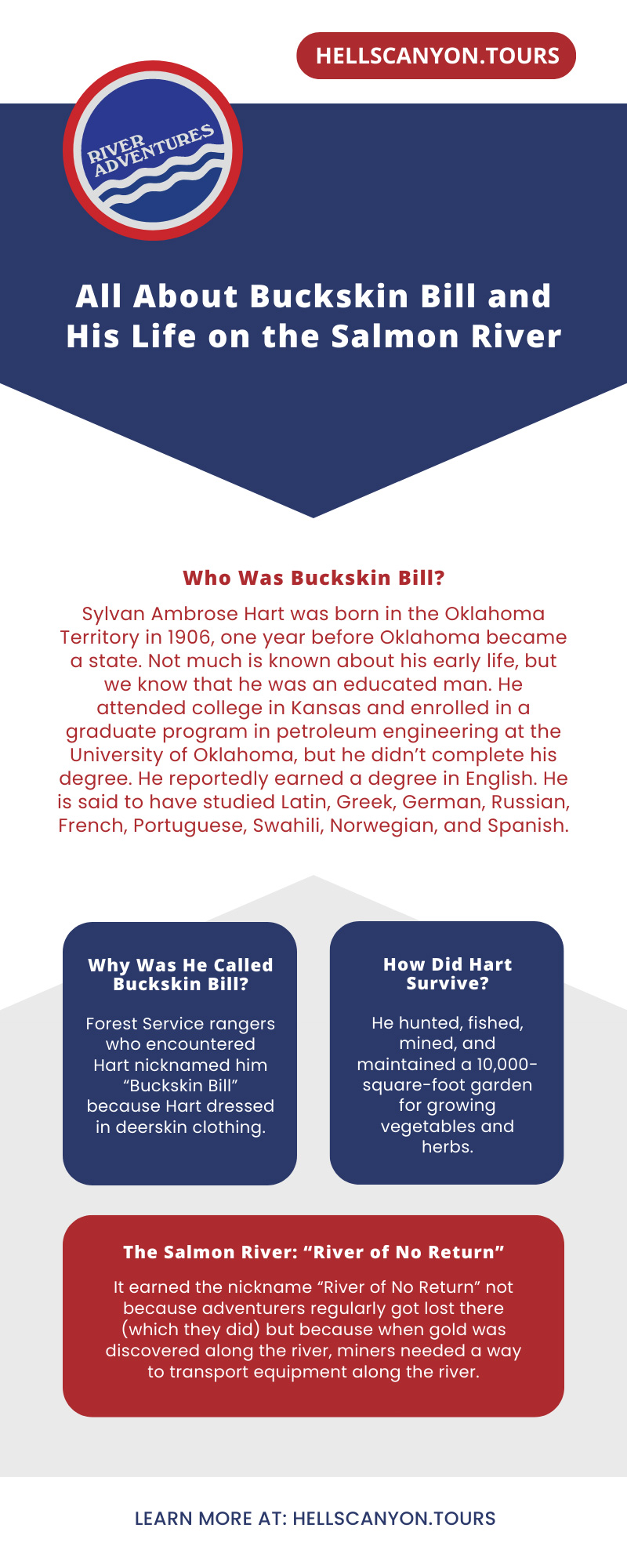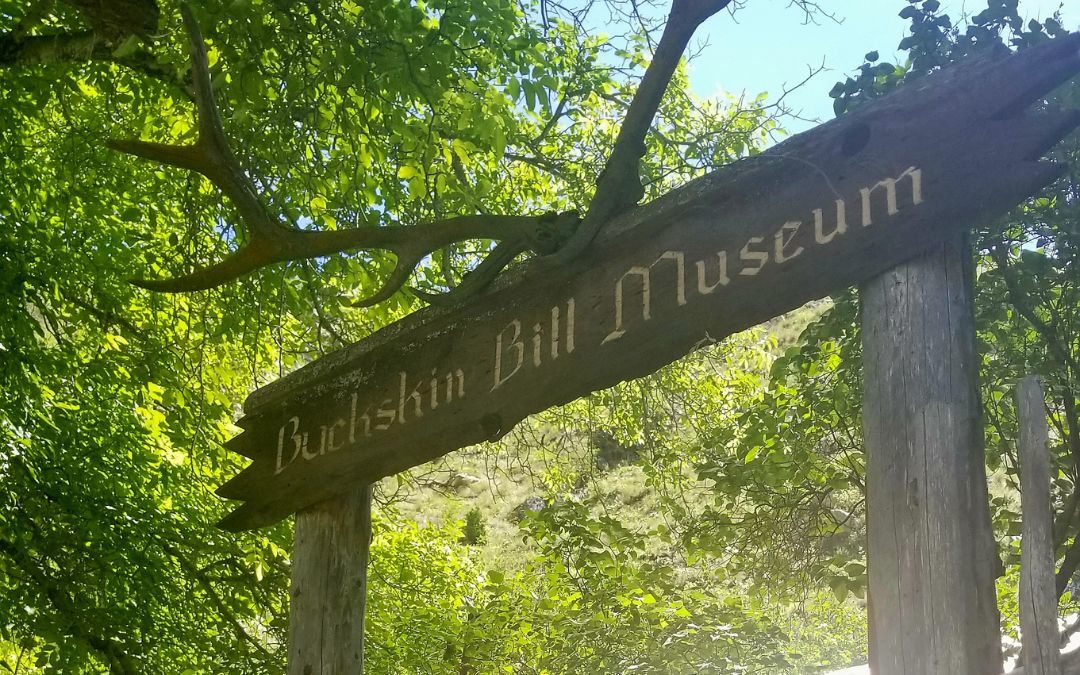You may think that tales of the Mountain Men are mere legends of the Old West—but you’d be wrong. A real Mountain Man lived alone in the rugged Idaho wilderness from 1932 until 1980. When you learn all about Buckskin Bill and his life on the Salmon River, you’ll be even more astounded by the extraordinary self-sufficiency and survival skills the Mountain Men needed to survive.
Who Was Buckskin Bill?
Sylvan Ambrose Hart was born in the Oklahoma Territory in 1906, one year before Oklahoma became a state. Not much is known about his early life, but we know that he was an educated man. He attended college in Kansas and enrolled in a graduate program in petroleum engineering at the University of Oklahoma, but he didn’t complete his degree. He reportedly earned a degree in English. He is said to have studied Latin, Greek, German, Russian, French, Portuguese, Swahili, Norwegian, and Spanish.
He is said to have worked in Texas oil fields during the Great Depression. Sometime around 1932 (accounts vary), he traveled to Idaho, where he purchased 50 acres of land along the Salmon River. There he built a compound that included a two-story cabin. The first floor was for winter and the second for summer living. Over the years, he also constructed a blacksmithing shop and a bomb shelter.
Although he tried to enlist to serve in World War II, Hart was rejected due to a heart condition. Instead, he was assigned to a Boeing plant in Kansas, where he worked on a bombsight system widely used during the war. After the war, he returned to his compound at Five Mile Bar along the Salmon River in Idaho, where he remained until his death in 1980.
Why Was He Called Buckskin Bill?
Forest Service rangers who encountered Hart nicknamed him “Buckskin Bill” because Hart dressed in deerskin clothing. Although he tanned the hides, he allegedly wore the deerskin with the hair against his skin.
How Did Hart Survive?
Buckskin Bill’s self-sufficiency went far beyond making his own clothing. He hunted, fished, mined, and maintained a 10,000-square-foot garden for growing vegetables and herbs.
He made all his own tools, including firearms. He made his own bullets, bored his own rifle, and used antlers as handles for knives and other tools. He also used found objects and discarded scrap, like an aircraft window, to adorn his home and make all the tools he needed to live and survive in the wilderness.
Buckskin Bill rarely used money. He was said to come into “town,” (Burgdorf, ID, population 6, in the summer) to purchase tea, books, and gunpowder using money he made mining.
The Salmon River: “River of No Return”
The Salmon River is in one of the most remote wilderness areas in the country. It earned the nickname “River of No Return” not because adventurers regularly got lost there (which they did) but because when gold was discovered along the river, miners needed a way to transport equipment along the river. They built wooden scows designed to handle the rapid current, but when the boats reached their destination, they were dismantled, and the lumber was used to build mining camps.
The canyons of the Salmon River run deeper than Arizona’s Grand Canyon, and are second only to the nearby Snake Rivers’ canyons in depth. Lewis and Clark elected not to attempt traveling along the Salmon (which Clark initially named for Lewis) because of its exceptionally rugged terrain and river rapids.
Not a Loner
Sylvan Hart welcomed visitors and regaled them with his opinions on just about everything. He was schooled in history and kept up with current events—at least enough to understand the nuclear threat of the Cold War. That’s why he built a bomb shelter on his property, blasting it out of solid rock. According to a 1966 profile published in Sports Illustrated, Buckskin Bill would welcome any other mountain people to his shelter if it became necessary.
As river rafting became more popular, more people ventured to visit Buckskin Bill. He would gladly give them a tour of his home, including a kitchen featuring an immense, elaborate samovar for tea that he had made. He even made a leather helmet in the Swiss guard style, which he was photographed wearing many times.
What About the Turret?
Although he was gregarious when visitors managed to reach him, Buckskin Bill was very protective of his property. In 1956, the National Forest Service moved to designate Bill’s property, and much of the Salmon River area, as a “primitive” area, which would have prohibited human habitation.
As a result of this threat, Buckskin Bill constructed a stone gun tower overlooking the river. He never used it to fire on anyone, and the Forest Service eventually backed down, allowing Bill to remain on the land. Eventually, the area was designated a wilderness, but authorities left Bill alone, perhaps in deference to his ability to live off the land for decades without causing disruption.
Death and Legacy
Buckskin Bill died on April 29, 1980, at the age of 73. He remained unmarried all his life. He was survived by three sisters and a nephew, according to an obituary published May 1, 1980, in the Lewiston Morning Tribune. After a funeral in Grangeville, ID, his body was returned to his homestead and buried there.
Buckskin Bill’s home has been transformed into a museum, displaying the astonishing array of meticulously crafted tools, guns, kitchenware, and knives he made and used during his life in the wilderness. Even his garden has been preserved and is cared for by a couple who were permitted to build a home near Buckskin Bill’s compound.
Now that you’ve learned all about Buckskin Bill and his life on the Salmon River, why not look into River Adventures’ tours to the Buckskin Bill museum? If the river is high enough to make the journey, we’ll take you upriver on the Salmon to see Buckskin Bill’s home and garden, as well as the amazing array of exquisitely crafted artifacts he left behind.
River Adventures can take you on a Salmon River jet boat tour that includes a visit to the Buckskin Bill Homestead and Museum. The tour also includes a stop at the Polly Beamis Ranch, the homestead of another enduring Idaho settler.
Find even more adventure on our Snake River jet boat tours through Idaho’s Hell’s Canyon area, where you will be awestruck by the beauty of the untouched Idaho wilderness. Contact River Adventures today for more information on planning your trip down the Salmon River, or to the Hell’s Canyon area on the Snake River. Schedule your River Adventures professionally guided tour in USCG-approved boats today.


Wide world of sports did A story on him back in 1976 I believe , Grits Grushom hosted it I found him fascinating .
I knew this man , when I was a child I would visit him in the summer time. He was scary and wonderful all in one guy. He had everything from a teepee to pickles cougar cubs in a big glass canning jar and much more. One of a kind. I would love to go back to see the museum.
I met him when my dad went on a fishing/lodge organized trip. I have pics of me sitting on his lap. He let us see his cabin and I agree it was a little creepy with dead animals in jars all over. I had no idea he was so young
Buckskin Bill was my grandmother’s brother. I was born in 1974. I never got to meet him. My parents visited him when I was very young. He must have been so very interesting! I hope to one day visit his property and the museum.
Jay Failing and I spent a month with him in 1970 after I read about him in a Sports illustrated article about him. I wrote a letter to him and said I wanted to write a report for an anthropology class at UCLA. He invited me to come stay with him. The highlight of the trip was Bill baking a peach cobbler using bear grease in the pastry. Bill gave Jay and I each a quart of bear grease to take home with us. I have pictures.